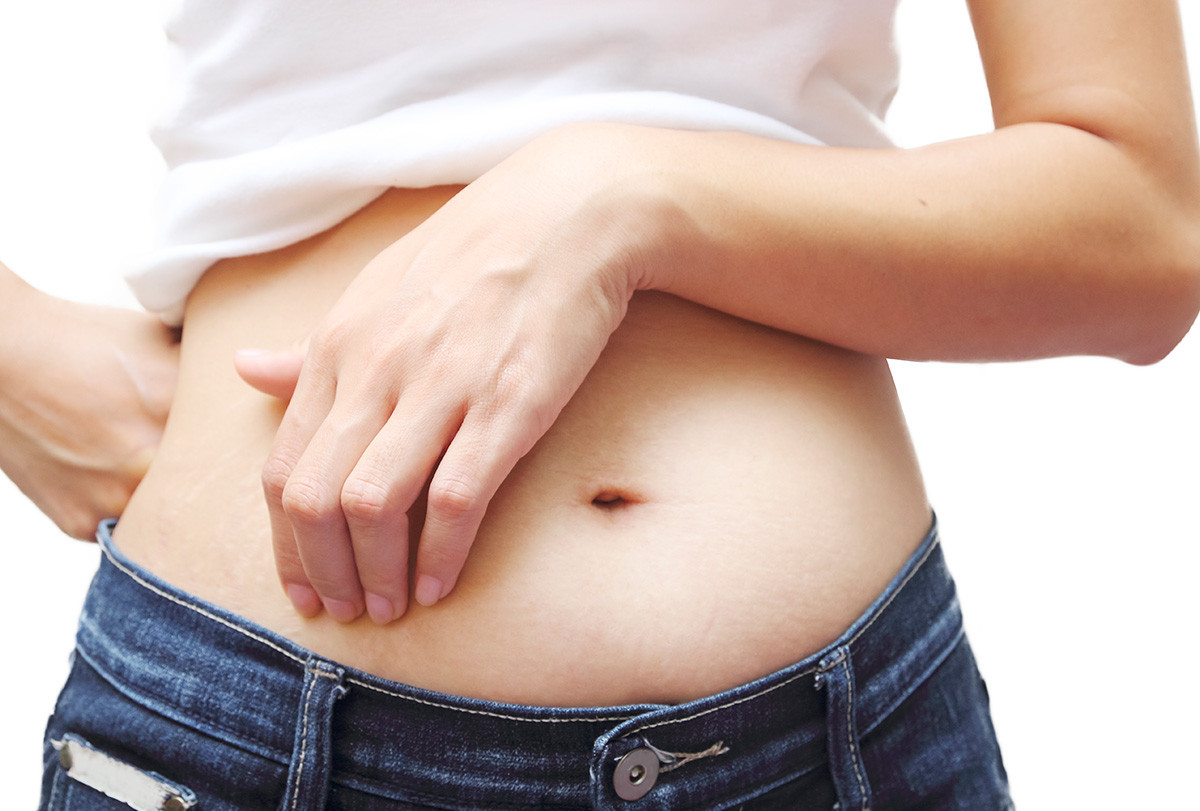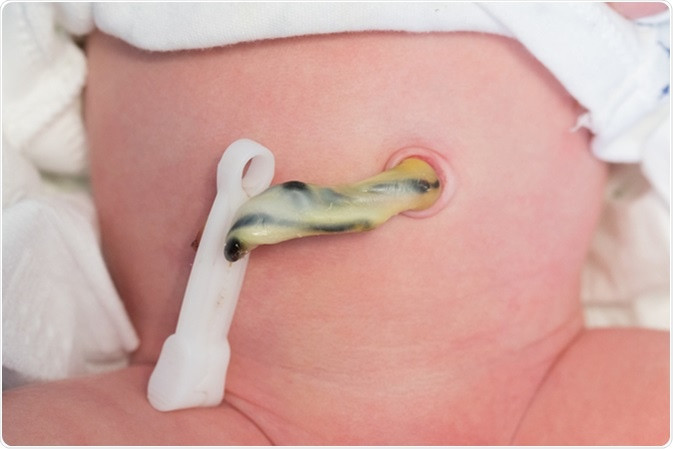Definition
Everyone has an umbilicus or navel, which is a small scar tissue on the abdomen resulting from the cutting of the umbilical cord at birth. The navel can appear either sunken or convex.
Similar to other areas of the skin, the umbilicus is susceptible to infection or injury. If there is pain, swelling, or fluid discharge, it could indicate an infection or injury. Due to its folded nature, dirt and bacteria trapped in the navel may multiply, leading to an increased risk of infection.
Causes
Umbilical infections can be caused by various factors, including:
- Bacterial Infection: The navel can harbor up to 67 types of bacteria. In cases where the navel is sunken, the folded skin can create a humid environment, leading to the accumulation of dirt. Warm, dark, and humid conditions are conducive to bacterial growth. Without proper cleaning, bacterial infections can occur.
- Fungal Infection: Natural skin fungi can grow in the navel, particularly when it is dirty and not kept dry. Candida albicans, a common fungus, can lead to conditions such as candidiasis. Candida thrives in humid and dark body parts.
- Infection Post Piercing: Infections may arise if the navel piercing procedure is conducted with non-sterile tools or hands. Improper treatment of the piercing location can also contribute to infection.
- Post-Surgery Infection: Following abdominal operations, such as hernia surgery, pus may discharge from the navel. Immediate medical attention is necessary, as this indicates an infection.
- Infected Urachal Cyst: During fetal development, the urachus connects the baby's bladder to the umbilical cord. Although it usually closes before birth, failure to close can lead to the formation of a fluid-filled cyst on the urachus. If infected, these cysts can contribute to navel infections.
- Infected Epidermoid Cyst: Epidermoid cysts, common on the skin, can form on the umbilicus. These cysts have walls similar to the skin's surface and are filled with keratin, a protein found in nails, skin, and hair. Infections of cysts on the navel can result in umbilicus infections.
- Omphalitis: Omphalitis is an infection at the base of the umbilical cord in newborns. After birth, the umbilical cord is clamped and cut near the base, leaving a small part that naturally detaches within 1-3 weeks. Improper care and procedures can lead to bacterial growth on the cord, causing infections.
Risk factor
The risk of developing an infection increases under certain conditions, including:
- Poor hygiene in umbilicus care.
- Sunken navel.
- Diabetes or other immune-weakening diseases.
- Invasive procedures or surgery around the navel area.
Risk factors for omphalitis include:
- Low birth weight.
- Premature birth.
- Ruptured amniotic membrane.
- Infection in the mother.
- Catheterization or intravenous lines in umbilical blood vessels.
- Extended labor duration.
- Unassisted birth.
- Improper treatment of the umbilical cord.
- Traditional practices with unsterilized items.
- Immune system disorders.
Symptoms
Symptoms of Umbilical Infection:
- Redness
- Pain
- Swelling
- Unpleasant odor
- Discharge of smelly, yellowish, or greenish pus or fluid
- Ulceration around the navel area
Symptoms of Urachal Cyst:
- Abdominal pain
- Fever
- Swelling in the abdomen
- Pain during urination
- Discharge of murky fluid or bleeding from the umbilicus
In a newborn, after the clamping and cutting of the umbilical cord, the formation of a scab on the end is normal. Mild bleeding can also occur, typically stopped easily with gentle pressure on the wound.
However, it's essential to be vigilant for symptoms and signs of infection, which include:
- Redness
- Swelling
- Pus from the skin around the umbilical cord
- Unpleasant odor
- Fever
- Irritability
- Weakness
- Reluctance to breastfeed
It's crucial to note that the last four symptoms—fever, irritability, weakness, and reluctance to breastfeed—can also be indicators of sepsis or the spread of infection throughout the body, signifying a more serious disease progression.
Diagnosis
To make a diagnosis, the doctor will inquire about the symptoms and the medical history of the individual, followed by a physical examination and additional examinations if necessary, including laboratory tests. The doctor may specifically examine the umbilical area and may collect fluid or cells from the umbilicus for further analysis in the laboratory. The laboratory will then examine the cells or fluid to identify the presence of any infection.
Management
The treatment for umbilical infections varies based on the underlying cause. Bacterial infections can be treated with antibiotic creams or ointments, while fungal infections may require antifungal powders or creams. Additional medications may be prescribed as needed.
Limiting sugar intake can be beneficial in restricting the growth of fungal infections, as fungi thrive in a sugary environment. Individuals with diabetes should manage their sugar levels by consulting with their doctor regularly.
For those who have recently undergone abdominal surgery, it is essential to care for their navel and remain vigilant for signs of infection. Keeping the umbilical skin dry and clean is crucial in preventing complications.
In the case of infected cysts producing fluid, the initial step involves addressing the infection, typically with antibiotics. Subsequently, the cyst itself must be attended to, as recurrence is possible if the root cause is not addressed. Doctors may recommend procedures such as laparoscopy or laser treatment to manage the cysts and reduce the likelihood of recurrent infections.
Complications
A severe complication of umbilical infection is sepsis, which can escalate into septic shock—a condition characterized by oxygen deprivation in body tissues due to the rapid spread of infection.
In newborns, the umbilical cord provides a direct pathway into circulation, allowing infections to spread quickly. Once the infection enters the bloodstream and causes sepsis, it can lead to damage in body tissues and organs, potentially resulting in a life-threatening situation. Premature babies are at a higher risk of complications due to their weaker immune systems.
Complications of omphalitis may include:
- Peritonitis: An infection of the thin layer lining the inner wall of the abdomen with abdominal organs.
- Intestinal Gangrene: The death of intestinal tissue due to limited blood flow.
- Liver Abscess: Accumulation of pus in a specific area of the liver.
- Myonecrosis: The death of muscle tissue due to inadequate blood circulation.
- Septic Embolization: Blockage of blood circulation caused by infection and bacteria.
- Fasciitis Necroticans: A serious bacterial infection that destroys the tissue beneath the skin.
- These complications can have severe consequences, including the risk of death.
Prevention
Follow these steps to care for your navel, ensuring its health and preventing infection:
- Wash daily with soap and water.
- Use the tip of your finger, a washcloth, or cotton to gently clean the inner fold of the umbilical area.
- Dry the inner part thoroughly after exposure to water.
- Refrain from applying cream or moisturizer to the umbilicus unless advised by a doctor. Creams can block the opening, promoting the growth of bacteria and fungi.
- Avoid tight and non-absorbent clothing, as they may irritate the navel and lead to the accumulation of sweat and dirt between clothes and skin.
- Refrain from scratching or piercing the navel. If it has been pierced, clean the pierced area regularly.
- Consult a doctor if there is pain or swelling in the umbilical area.
To prevent infection on the umbilical cord in newborns, follow these steps:
- Address Maternal Infections During Pregnancy: Ensure the mother receives treatment for infections during pregnancy, preventing the risk of amniotic membrane and umbilical cord infection. Consult a doctor if there are signs of water breaking, fever, or smelly vaginal discharge during pregnancy.
- Clean Hands Before Touching the Umbilical Cord
- Use Clean Tools for Cord Cutting
- Avoid Pulling the Umbilical Cord
- Dry Treatment for the Umbilical Cord
- Refrain from applying skin powder or homemade treatments on the umbilical cord.
- Prompt Cleaning If Touched by Urine or Feces:
- Clean the umbilical cord promptly if it comes into contact with urine or feces.
- Follow Doctor's Advice for Hygiene
- Roll Diapers to Avoid Contact with the Cord: Roll the diaper to prevent it from touching the umbilical cord, preventing irritation and promoting dryness and exposure to air.
- Monitor Shape and Color Changes of the Cord Root
- Prioritize Breastfeeding, Especially Directly: Opt for breastfeeding, especially direct skin-to-skin contact between the mother and child. This practice exposes the baby to normal bacteria, reducing the risk of umbilical cord infection by 36%. Breastfeeding also provides antibodies and supports the growth of a stronger immune system to fight off diseases.
When to see a doctor?
Visit the doctor if you or your newborn experience:
- Fever
- Pus or fluid discharge from the navel
- Pain or difficulty during urination
- Abdominal muscle pain
- Redness in the navel area
- Tenderness in the navel area
Every infection in a newborn, including omphalitis, can be an emergency condition. Omphalitis is fatal for 15% of newborns and requires prompt treatment to reduce the risk of complications. Contact the doctor or seek emergency care if the baby shows signs and symptoms of infection, if symptoms do not improve after 1-2 days, if there is a worsening of symptoms, or if new symptoms arise.
Looking for more information about other diseases? Click here!
- dr Nadia Opmalina
Kushchmider R. (2021). Things that can go wrong with your belly button. Retrieved 2 January 2022, from https://www.webmd.com/a-to-z-guides/features/things-that-can-go-wrong-bellybutton
Watson S. (2021). What’s causing your belly button discharge?. Retrieved 29 Desember 2021, from https://www.healthline.com/health/belly-button-discharge
Johnson J. (2017). All you need to know about belly button discharge. Retrieved 29 Desember 2021, from https://www.medicalnewstoday.com/articles/319864
Villines Z. (2018). How do you treat an infected belly button piercing?. Retrieved 2 January 2022, from https://www.medicalnewstoday.com/articles/323547
Painter K, Anand S, Philip K. (2021). Omphalitis Retrieved 2 January 2022, from https://www.ncbi.nlm.nih.gov/books/NBK513338/
Christiano D. (2019). Retrieved 28 Desember 2021, from https://www.healthline.com/health/baby/infected-umbilical-cord
Villines Z. (2020). Retrieved 28 Desember 2021, from https://www.medicalnewstoday.com/articles/infected-umbilical-cord
Gallagher PG. (2019). Omphalitis. Retrieved 28 Desember 2021, from https://emedicine.medscape.com/article/975422-overview
Painter K, Anand S, and Philip K. (2021). Omphalitis. Retrieved 28 Desember 2021, from https://www.ncbi.nlm.nih.gov/books/NBK513338/









